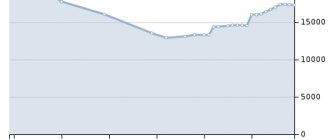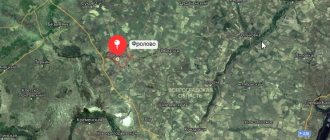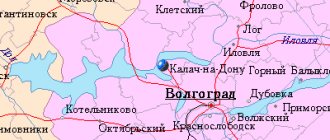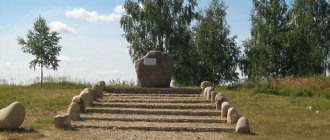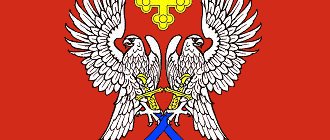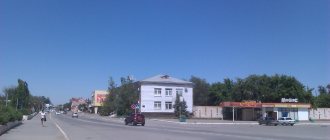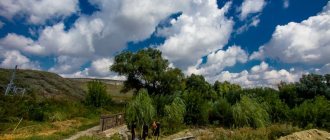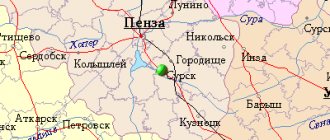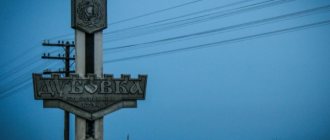Novoanninsky
Ancient settlements
It has been established that the lands in the bends of Buzuluk were inhabited even before our era by the Sarmatians. In the place where the city of Novoanninsky is located today, one of the Sarmatian tribes buried noble warriors and leaders. Archaeologists discovered a mound here with numerous gold decorations and utensils.
Ancient artifacts are found in the city to this day. For example, in 2009, funeral service workers excavated a bronze vessel and a mirror at the city cemetery. As archaeologists suggest, these objects were placed in the tomb of the leader of the Sarmatian tribe; the vessel was discovered on the site of tombs that belonged to noble representatives of the Sarmatian tribes. Specialists from the regional committee for culture dated the pottery to the 1st–2nd centuries BC, which corresponds to the Sarmatian era.
Farmsteads - predecessors of the city
In the 19th century, on the site of the modern city of Novoanninsky, there were the villages of Privokzalny, Gromok and Perevozinsky.
In 1828, on the lands of the Khopersky district of the Don Army, on the banks of the Buzuluk River, the first dwellings began to appear, and later the farmstead founded here received the name Gromok Filonovskaya Stanitsa. The Filatovs and Goremykins settled in it. At the same time, 3–4 km from him, on the banks of the Perevozinka River, the Anichkins’ first hut appeared. Later, when other huts appeared here, the settlement began to be called the Perevozinsky farmstead of the Anninskaya village. By 1852, the number of Cossacks living on the Perevozinsky farm reached 52 people, and on the Gromok farm - 29 people.
In 1868, construction began on the Gryaze-Tsaritsyn railway, which was supposed to pass through the Khopersky district and, in particular, through the village of Filonovskaya, the largest trading village at that time along the Buzuluk River. Railways at that time were not yet widespread; many believed that the passage of the railway track near settlements would damage the local economy. Only time has shown the fallacy of this point of view. At the general military council of the Cossacks, it was decided not to give consent to laying a railway through the lands of the village. After much persuasion, which was unsuccessful, in the Borisoglebsk concession campaign it was decided to build the Gryaze-Tsaritsyn railway near the village of Anninskaya.
In 1869, the first dugouts appeared, housing construction workers from Voronezh. The local population was also involved in the work; local residents transported stone, rails and sleepers on oxen for a good fee. The first office premises appeared. The first railway bridge across the Buzuluk River, 50 fathoms (more than 100 m) long, was being built, grandiose for those times.
On December 26, 1870, train traffic was opened on the Borisoglebsk - Filonovo line, and thus a new station appeared - “Filonovo” of the Gryaze-Tsaritsyn Railway. Already on July 25, 1871, through traffic began to the city of Tsaritsyn. The Filonovo station was assigned class II; a two-story station was built on it from red brick. Railroad tracks with a length of 2,726 fathoms were assigned to the station. Along the railway track, every 2 versts there were trackman's booths with crossings. The concession campaign bought 30 fathoms of land from local Cossacks for construction on both sides of the road at 28 rubles per dessiatine. The total cost of building the railway from Tsaritsyn to Borisoglebsk was about 400 thousand rubles.
Dugouts appeared near the station, residential buildings and workshops were built. The station attracted people from nearby farms and villages; the presence of a railway connection, which contributed to the development of entrepreneurship and trade, attracted merchants and industrialists.
In the List of populated places of the Don Army Region for 1873, there are farmsteads located on the site of the modern city of Novoanninsky near the Filonovo station, which is designated in the document as “Filonov”. In the Gromkovsky farm (yurt of the Filonovskaya village, 1 verst from the Filonov station) 28 households and 185 residents of both sexes are indicated - 91 males and 94 females. In the farmstead there were: 21 plows, 84 horses, 73 pairs of oxen, 232 other cattle, 679 simple sheep. In the Perevozinsky farm (yurt of the Anninskaya village, 2 versts from Filonov station) 44 households and 351 inhabitants are indicated – 169 males and 182 females. The farmstead farms included: 38 plows, 208 horses, 118 pairs of oxen, 388 other cattle, 1623 simple sheep. not included in settlements.
Khutor Privokzalny
The village of Privokzalny arose at the Filonovo station. Merchants from the village of Filonovskaya - Kurilin and Podgornov - moved here; one, having built a windmill, processed grain into flour, the other was engaged in buying bread for further sale. Then the Bakhrushins, Stepanovs, Popovs, Minaev, Degtyarev, Komarov, Mokrousov, Sidorov, Loginov and others settled here. From Voronezh they sent the station chief Ogarkov, telegraph operators Krylov and Gubanov, employees Rudakov, Smirnov and Gaidukov, a gendarme - the Pole Yaroshevich.
The convenient location of Privokzalny near the railway station led to its further development and transformation into a trade center for nearby villages. So much bread was brought to the station that there were not enough wagons to send it. Huge warehouses were built nearby to store grain; it was stored in bags in piles and covered with tarpaulin. They tried not to accept Cossacks, as persons liable for military service, for permanent work on the railway, since they could be called up for military service at any time.
Station at the beginning of the 20th century
According to information from 1897, 1,560 people already lived in Privokzalny. In 1901, 74 commercial and industrial establishments were registered in the farmstead, and in the same year a telegraph began operating here. In 1907, Privokzalny was considered a large industrial and commercial center. Among its inhabitants there were many wealthy people, and the merchant class predominated here. In the journal of the regional government of the Don Army for March 14, 1906 about
.
I wonder what the range of trade was, other than agricultural products. In the advertising publication of the trading house of Mikhail and Fyodor Dutikov, placed on the receipt form for August 4, 1912, it is indicated that the trading house offers from the warehouse: American mowing machines, binders, rakes; plows of both our own production and those of other factories; Russian reapers, threshers, winnowers, sorters, seeders, straw cutters, weeders, carts, millstones, fire pipes, closet pumps, etc.
After a visit to Privokzalny by the ataman of the Don Army, General Alexander Vasilyevich Samsonov, in 1911 the farm was renamed Samsonovsky.
The local history museum of the city of Novoanninsky houses many interesting documents. The Donskie Vedomosti newspaper on April 1, 1914 published an article “Samsonov Farm (Anninskaya Stanitsa),” which indicated that the farm had grown so much in recent years that it would rather pass for a cultural district town. From the article it is clear that there was a power station and a bank, excellent shops, and philistine houses. It is noted that this is a farmstead “by name only.” From the deed of 1916, also kept in the museum, you can get an idea of the houses of local residents. The document states that the peasant woman Anisya Klyuchevskaya owned a wooden house, lined with brick and with a brick bottom, covered with iron, the house had two rooms above and one room below, outbuildings and a fence, a front garden, an orchard, a wooden kitchen in the yard, covered with planks, a well, a brick cellar and a glacier. She sold this house to the Cossack Smirnov for 1,750 rubles.
After the revolution
Before the revolution, the farms of Gromkovsky, Samsonovsky and Perevozinsky existed separately. Soon after the revolution, in 1918, they were united into one settlement, which received the status of a village and the name Novo-Annenskaya. In 1935, the village became the center of the newly formed Novo-Annensky district. By the decision of the Presidium of the All-Russian Central Executive Committee of August 1, 1936, the village of Novo-Annenskaya received the status of a workers' village.
As of January 1, 1956, the population of the village of Novo-Annensky was 25,690 people. By decree of the Presidium of the Supreme Council of June 14, 1956, the workers' settlement of Novo-Annensky was given the status of a city. It is noteworthy that in documents from 1936–1960. the name of the city was written as Novo-Anninsky, and after 1960 - Novoanninsky.
According to the All-Union Population Census for 1979, 22,180 people lived in the city of Novoanninsky. In 1989, the revival of the Cossacks began in the city.
Story
Novoanninsky district
established by the Resolution of the Presidium of the All-Russian Central Executive Committee on June 23, 1928 as part of the Khopyorsky district of the Lower Volga region.
Since 1934, as part of the Stalingrad region, since 1936 - as part of the Stalingrad (Volgograd) region[5].
On November 12, 1960, part of the territory of the abolished Budarinsky district was annexed to the Novoanninsky district[6].
On December 21, 2004, in accordance with the Law of the Volgograd Region No. 970-OD[7], the district was granted the status of a municipal district. It consists of 14 municipalities: 1 urban and 13 rural settlements.
Municipal-territorial structure
In the Novoanninsky municipal district there are 14 municipalities, including 1 urban settlement and 13 rural settlements[26]:
| № | Municipality | Administrative center | Number of settlements | Population (persons) | Area (km²) |
| 1 | urban settlement Novoanninsky city | Novoanninsky city | 2 | ↘15 794[4] | 63,31[3] |
| 2 | Amovskoe rural settlement | village Village of the state farm "AMO" | 5 | ↘1040[4] | 196,08[3] |
| 3 | Berezovskoe rural settlement | village Berezovka 1st | 5 | ↘1072[4] | 181,31[3] |
| 4 | Bocharovskoe rural settlement | Bocharovsky farm | 5 | ↘1149[4] | 276,88[3] |
| 5 | Galushkinskoe rural settlement | Galushkinsky farm | 4 | ↘1029[4] | 188,64[3] |
| 6 | Deminskoe rural settlement | Deminsky farm | 8 | ↘1283[4] | 295,31[3] |
| 7 | Krasnokorotkovskoe rural settlement | Krasnokorotkovsky farm | 3 | ↘788[4] | 128,08[3] |
| 8 | Novokievskoye rural settlement | Novokievka village | 6 | ↘799[4] | 225,89[3] |
| 9 | Panfilovskoye rural settlement | Panfilovo village | 8 | ↘2576[4] | 281,94[3] |
| 10 | Field rural settlement | Polevoy village | 4 | ↘336[4] | 153,86[3] |
| 11 | Staroanninskoye rural settlement | village Staroanninskaya | 8 | ↘1808[4] | 362,13[3] |
| 12 | Trostyanskoe rural settlement | Trostyansky village | 4 | ↘859[4] | 243,83[3] |
| 13 | Filonovskoye rural settlement | village Filonovskaya | 4 | ↘1630[4] | 262,03[3] |
| 14 | Cherkesovskoe rural settlement | Cherkesovsky farm | 4 | ↘1290[4] | 219,03[3] |
Economy
Agriculture
Main specialization of Novoanninsky district
- production of agricultural products - food and feed wheat, corn, sunflower, buckwheat. The region has developed meat and dairy farming, pig and sheep breeding, processing industry and trade and intermediary activities.
The largest agricultural enterprises are: SPK "Staroanninsky", SPK "Galushkinsky", LLC "Getex", LLC "Helio-Pax-Agro-3", LLC "Amo", LLC "Troetskoye", LLC Filonovsky breeding plant, collective farm breeding plant named after. Kalinin, whose field of activity is the production, procurement, processing and sale of agricultural products, as well as the provision of transport services for harvesting.
Industry
The largest industrial enterprises of the Novoanninsky district
are: OJSC Novoanninsky Plant of Electromedical Equipment, LLC Agrosnab, Agroholding Novoanninsky, LLC Novoanninsky Foundry-Mechanical, OJSC Filonovsky Meat Processing Plant.
Trade
Settlements
The Novoanninsky district includes 70 settlements[27][26].
| List of settlements in the region | ||||
| № | Locality | Type | Population | Municipality |
| 1 | Alimov-Lyubimovsky | farm | ↘140[28] | Panfilovskoye rural settlement |
| 2 | Alsyapinsky | farm | 152[15] | Galushkinskoe rural settlement |
| 3 | Amochaevsky | farm | 30[15] | Cherkesovskoe rural settlement |
| 4 | Atamanovsky | farm | 18[15] | Trostyanskoe rural settlement |
| 5 | Berezovka 1st | farm | 698[15] | Berezovskoe rural settlement |
| 6 | Berezovka 2nd | farm | 268[15] | Berezovskoe rural settlement |
| 7 | Big Golovsky | farm | 208[15] | Deminskoe rural settlement |
| 8 | Bolshoi Dubovsky | farm | 53[15] | Deminskoe rural settlement |
| 9 | Borisovsky | farm | 137[15] | Staroanninskoye rural settlement |
| 10 | Bocharovsky | farm | 583[15] | Bocharovskoe rural settlement |
| 11 | Budyonnovsky | farm | 29[15] | Krasnokorotkovskoe rural settlement |
| 12 | Burnatsky | farm | 152[15] | Amovskoe rural settlement |
| 13 | Verbochny | farm | 53[15] | Field rural settlement |
| 14 | Funny | farm | 77[15] | Staroanninskoye rural settlement |
| 15 | Vikhlyaevsky | farm | 42[15] | Deminskoe rural settlement |
| 16 | Oriental | village | 76[15] | Field rural settlement |
| 17 | Galushkinsky | farm | 867[15] | Galushkinskoe rural settlement |
| 18 | State Forest Nursery | village | 57[15] | Filonovskoye rural settlement |
| 19 | Gulyaevsky | farm | 242[15] | Bocharovskoe rural settlement |
| 20 | Deminsky | farm | 839[15] | Deminskoe rural settlement |
| 21 | Drobyazkin | farm | 116[15] | Novokievskoye rural settlement |
| 22 | Durnovsky | farm | 432[15] | Staroanninskoye rural settlement |
| 23 | Zaprudny | village | ↗9[28] | Panfilovskoye rural settlement |
| 24 | Star | farm | 49[15] | Cherkesovskoe rural settlement |
| 25 | Ivanovsky | farm | ↗86[28] | Panfilovskoye rural settlement |
| 26 | Karpovsky | farm | 73[15] | Bocharovskoe rural settlement |
| 27 | Kirpichevsky | farm | 87[15] | Galushkinskoe rural settlement |
| 28 | Kleimenovsky | farm | 123[15] | Deminskoe rural settlement |
| 29 | Kozlinovsky | farm | 248[15] | Staroanninskoye rural settlement |
| 30 | Kosovo | farm | 98[15] | Deminskoe rural settlement |
| 31 | Red Dawn | farm | ↘295[28] | Panfilovskoye rural settlement |
| 32 | Krasnogorsky | farm | 122[15] | Amovskoe rural settlement |
| 33 | Krasnokorotkovsky | farm | 570[15] | Krasnokorotkovskoe rural settlement |
| 34 | Kuznetsovsky | farm | 237[15] | Bocharovskoe rural settlement |
| 35 | Maly Dubovsky | farm | 33[15] | Deminskoe rural settlement |
| 36 | Martynovsky | farm | 293[15] | Deminskoe rural settlement |
| 37 | Makhinovsky | farm | 71[15] | Novokievskoye rural settlement |
| 38 | Novoanninsky | city | ↘15 791[4] | urban settlement Novoanninsky city |
| 39 | Novokievka | farm | 762[15] | Novokievskoye rural settlement |
| 40 | Novoselsky | village | ↗526[28] | Panfilovskoye rural settlement |
| 41 | Department No. 1 of the state farm "AMO" | village | 98[15] | Amovskoe rural settlement |
| 42 | Department No. 2 of the state farm "AMO" | village | 132[15] | Amovskoe rural settlement |
| 43 | Panfilovo | village | ↗1853[28] | Panfilovskoye rural settlement |
| 44 | Pereshchepnovsky | farm | 78[15] | Staroanninskoye rural settlement |
| 45 | Field | village | 355[15] | Field rural settlement |
| 46 | Poltavsky | farm | 102[15] | Novokievskoye rural settlement |
| 47 | Popov | farm | 250[15] | Trostyanskoe rural settlement |
| 48 | Popovsky | farm | 96[15] | Berezovskoe rural settlement |
| 49 | Pyshkinsky | farm | 18[15] | Field rural settlement |
| 50 | Rogachev | farm | 92[15] | Cherkesovskoe rural settlement |
| 51 | Rog-Izmailovsky | farm | 336[15] | Krasnokorotkovskoe rural settlement |
| 52 | Rodnikovsky | farm | 139[15] | Staroanninskoye rural settlement |
| 53 | Rozhnovsky | farm | 312[15] | Filonovskoye rural settlement |
| 54 | Salomatin | farm | 374[15] | Filonovskoye rural settlement |
| 55 | Satarovsky | farm | 243[15] | Bocharovskoe rural settlement |
| 56 | state farm "AMO" | village | 782[15] | Amovskoe rural settlement |
| 57 | Staroanninskaya | village | 808[15] | Staroanninskoye rural settlement |
| 58 | Strahovsky | farm | 31[15] | Novokievskoye rural settlement |
| 59 | Tavolzhansky | farm | 162[15] | Staroanninskoye rural settlement |
| 60 | Talovsky | farm | 10[15] | Novokievskoye rural settlement |
| 61 | Troetsky | farm | ↗229[28] | Panfilovskoye rural settlement |
| 62 | Trostyansky | village | 627[15] | Trostyanskoe rural settlement |
| 63 | Labor-Dawn | farm | ↘101[28] | Panfilovskoye rural settlement |
| 64 | Udodovsky | farm | 182[15] | Trostyanskoe rural settlement |
| 65 | Uchkhoz Novoanninsky Agricultural Technical School | village | ↘3[4] | urban settlement Novoanninsky city |
| 66 | Filonovskaya | village | 1227[15] | Filonovskoye rural settlement |
| 67 | Chelyshevsky | farm | 129[15] | Galushkinskoe rural settlement |
| 68 | Cherkesovsky | farm | ↘1545[15] | Cherkesovskoe rural settlement |
| 69 | Yaryzhensky | farm | 171[15] | Berezovskoe rural settlement |
| 70 | Yastrebovsky | farm | 4[15] | Berezovskoe rural settlement |
Population
| Population | ||||||||
| 1939[8] | 1959[9] | 1970[10] | 1979[11] | 1989[12] | 2002[13] | 2009[14] | 2010[15] | 2011[16] |
| 33 762 | ↘33 409 | ↗57 386 | ↘50 491 | ↘44 758 | ↘41 611 | ↘37 249 | ↗37 306 | ↘37 177 |
| 2012[17] | 2013[18] | 2014[19] | 2015[20] | 2016[21] | 2017[22] | 2018[23] | 2019[24] | 2020[25] |
| ↘36 441 | ↘35 827 | ↘35 263 | ↘34 743 | ↘34 253 | ↘33 679 | ↘33 121 | ↘32 452 | ↘31 878 |
| 2021[4] | ||||||||
| ↘31 453 | ||||||||
Urbanization
50.21% of the district's population live in urban areas (Novoanninsky city).
Gender composition
- men - 46.3%;
- women - 53.7%.
